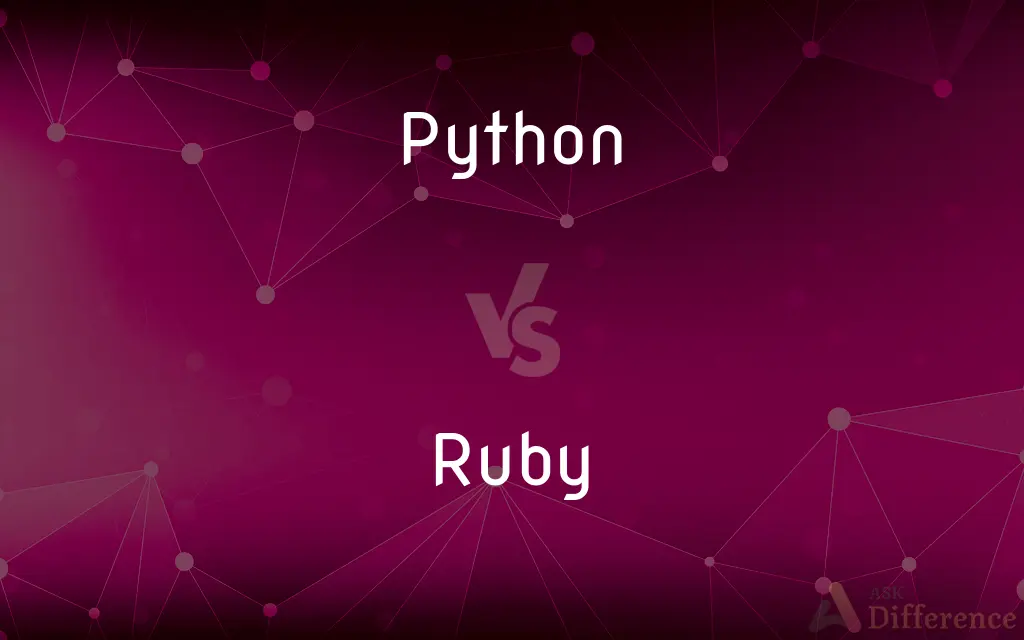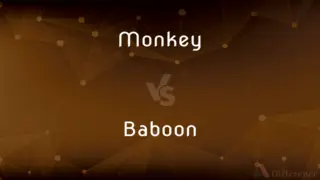Python vs. Ruby — What's the Difference?
By Fiza Rafique & Maham Liaqat — Updated on March 21, 2024
Python is often praised for its clear syntax and readability, making it ideal for beginners, while Ruby is lauded for its elegant and expressive code, particularly favored in web development.

Difference Between Python and Ruby
Table of Contents
ADVERTISEMENT
Key Differences
Python emphasizes simplicity and readability, making it a great choice for beginners and large-scale applications. It has a diverse range of applications, from web development with Django to data analysis with Pandas. Python's syntax is straightforward, aiming for clarity and simplicity in coding. Ruby, on the other hand, is renowned for its elegance and the principle of least astonishment (POLA), which means the language is designed to behave in a way that minimizes surprises for experienced users. It's the backbone of the Ruby on Rails web framework, making it a powerhouse for web development. Ruby's syntax allows for expressive code that can do a lot with few lines, appealing to developers looking for a more natural coding style.
Python benefits from a vast ecosystem and a large standard library, known as the Python Package Index (PyPI), which provides tools and libraries for various applications, including scientific computing, image processing, and machine learning. This extensive support makes Python highly versatile and widely used in both academia and industry. Ruby shines in its community and gem ecosystem, with RubyGems providing a wealth of libraries (gems) that make it easy to add functionality to projects. Ruby on Rails, in particular, offers conventions that streamline web development, allowing developers to build applications quickly and efficiently with less code.
Performance-wise, Python and Ruby are often compared, with Python generally leading in speed and efficiency due to optimizations like PyPy, a just-in-time compiler. However, real-world application performance can depend more on the specific task and how the code is written than on the language itself.
In terms of concurrency, Python uses the Global Interpreter Lock (GIL), which can be a limitation when trying to execute multiple threads simultaneously. This makes Python less ideal for applications requiring high concurrency. Ruby, with implementations like JRuby and Rubinius, offers more options for true parallelism and concurrency, potentially offering better performance in multi-threaded scenarios.
Both languages have strong support for object-oriented programming (OOP), but they approach it differently. Python uses a more traditional approach to OOP, with a clear distinction between classes and instances. Ruby, however, follows a more pure OOP model, where everything is an object, including primitive types like integers and booleans, allowing for a highly consistent and flexible coding style.
ADVERTISEMENT
Comparison Chart
Design Philosophy
Emphasizes simplicity and readability.
Focuses on elegance and developer happiness.
Syntax
Clear and strict, aiming for simplicity.
Expressive and flexible, allowing for more concise code.
Use Case
Broad, including web development, data analysis, and more.
Primarily web development, especially with Ruby on Rails.
Ecosystem
Large standard library and PyPI for packages.
Rich gem ecosystem with RubyGems.
Performance
Generally faster due to optimizations like PyPy.
Can be slower, but real-world performance varies.
Concurrency
Global Interpreter Lock (GIL) limits true concurrency.
Better support for concurrency with implementations like JRuby.
OOP Approach
Traditional, with a clear class-instance distinction.
Everything is an object, offering a highly consistent model.
Compare with Definitions
Python
Comes with a wide range of modules and functions for various tasks.
Python's os module provides a way to interact with the operating system.
Ruby
Ruby has a unique way of handling blocks of code and closures.
Ruby's each method can take a block directly for iterating over collections.
Python
Python code is executed line by line, making debugging easier.
Running a Python script requires no compilation step.
Ruby
This allows for a very consistent approach to programming.
In Ruby, even numbers are objects with their own methods.
Python
The type of a variable is checked at runtime, which adds flexibility.
In Python, x = 10 can be followed by x = ten.
Ruby
Ruby aims to behave in a way that minimizes confusion for users.
Ruby methods tend to have names that clearly describe their functionality.
Python
Blocks of code are defined by their indentation, enhancing readability.
In Python, loops and conditionals rely on indentation.
Ruby
Allows more flexibility in coding by determining types at runtime.
In Ruby, x = 100 can later change to x = hundred.
Python
Including procedural, object-oriented, and functional programming.
Python functions can be passed around as objects.
Ruby
Ruby code runs directly, facilitating rapid development cycles.
A Ruby application doesn't need to be compiled before it's run.
Python
A large heavy-bodied non-venomous snake occurring throughout the Old World tropics, killing prey by constriction and asphyxiation.
Ruby
A precious stone consisting of corundum in colour varieties varying from deep crimson or purple to pale rose
A ruby eternity ring
A necklace of rubies
Python
A high-level general-purpose programming language.
Ruby
An old type size equal to 51/2 points.
Python
Greek Mythology A dragon or serpent that was the tutelary demon of the oracular cult at Delphi until killed and expropriated by Apollo.
Ruby
A red, translucent variety of the mineral corundum, highly valued as a precious stone.
Python
A soothsaying spirit or demon.
Ruby
Something, such as a watch bearing, that is made from a ruby.
Python
A person possessed by such a spirit.
Ruby
A dark or deep red to deep purplish red.
Python
Any of various nonvenomous snakes of the family Pythonidae, found chiefly in Asia, Africa, and Australia, that coil around and asphyxiate their prey. Some pythons can attain lengths of 8 meters (26 feet) or more.
Ruby
Of the color ruby.
Python
A type of large constricting snake.
Ruby
A clear, deep, red variety of corundum, valued as a precious stone.
Python
A penis.
Ruby
(obsolete) A red spinel.
Python
Any species of very large snakes of the genus Python, and allied genera, of the family Pythonidæ. They are nearly allied to the boas. Called also rock snake.
Ruby
A deep red colour.
Python
A diviner by spirits.
Ruby
(tincture) The tincture red or gules.
Python
Large Old World boas
Ruby
The size of type between pearl and nonpareil, standardized as 5½-point.
Python
A soothsaying spirit or a person who is possessed by such a spirit
Ruby
A ruby hummer, a South American hummingbird, Clytolaema rubricauda.
Python
(Greek mythology) dragon killed by Apollo at Delphi
Ruby
A red bird-of-paradise, Paradisaea rubra.
Ruby
A pronunciation guide written above or beside Chinese or Japanese characters.
Ruby
Of a deep red colour.
Ruby
To make red; to redden.
Ruby
A precious stone of a carmine red color, sometimes verging to violet, or intermediate between carmine and hyacinth red. It is a red crystallized variety of corundum.
Of rubies, sapphires, and pearles white.
Ruby
The color of a ruby; carmine red; a red tint.
The natural ruby of your cheeks.
Ruby
That which has the color of the ruby, as red wine. Hence, a red blain or carbuncle.
Ruby
Any species of South American humming birds of the genus Clytolæma. The males have a ruby-colored throat or breast.
Ruby
Ruby-colored; red; as, ruby lips.
Ruby
To make red; to redden.
Ruby
A transparent piece of ruby that has been cut and polished and is valued as a precious gem
Ruby
A transparent deep red variety of corundum; used as a gemstone and in lasers
Ruby
A deep and vivid red
Common Curiosities
Is Python or Ruby better for beginners?
Both are considered beginner-friendly, but Python's syntax and extensive use in education might make it a slightly easier starting point.
How does Python's syntax contribute to its popularity?
Python's clear and readable syntax makes it accessible to beginners and maintains code clarity at scale, contributing to its wide adoption.
What makes Ruby unique in web development?
Ruby, particularly through Ruby on Rails, offers rapid development, elegant syntax, and a convention over configuration approach that speeds up the development process.
How do Python and Ruby handle concurrency?
Python uses a Global Interpreter Lock (GIL), which can limit concurrency, while Ruby, with certain implementations, provides better support for true parallelism.
What role do libraries and frameworks play in Python and Ruby's ecosystems?
Both languages have rich ecosystems, but Python's extensive standard library and PyPI for external packages, and Ruby's gems and Rails framework, cater to different needs and development philosophies.
How do Python and Ruby compare in terms of community and support?
Both have vibrant communities and extensive documentation in terms of community and support.
Can Ruby's performance be a limitation?
While Ruby might not match Python in performance benchmarks, for many web applications, its productivity and rapid development compensate for any speed differences.
What is Python best used for?
Python is versatile, ideal for web development, data analysis, artificial intelligence, scientific computing, and more.
What are Python's strengths in data science and machine learning?
Python's strengths lie in its vast array of libraries like NumPy, Pandas, and scikit-learn, which provide powerful tools for data analysis and machine learning tasks.
Can Ruby be used for tasks beyond web development?
Yes, although Ruby is most famous for web development with Rails, it is a versatile language that can be used for data processing, automation, and scripting.
Share Your Discovery

Previous Comparison
Goods vs. Services
Next Comparison
Monkey vs. BaboonAuthor Spotlight
Written by
Fiza RafiqueFiza Rafique is a skilled content writer at AskDifference.com, where she meticulously refines and enhances written pieces. Drawing from her vast editorial expertise, Fiza ensures clarity, accuracy, and precision in every article. Passionate about language, she continually seeks to elevate the quality of content for readers worldwide.
Co-written by
Maham Liaqat















































